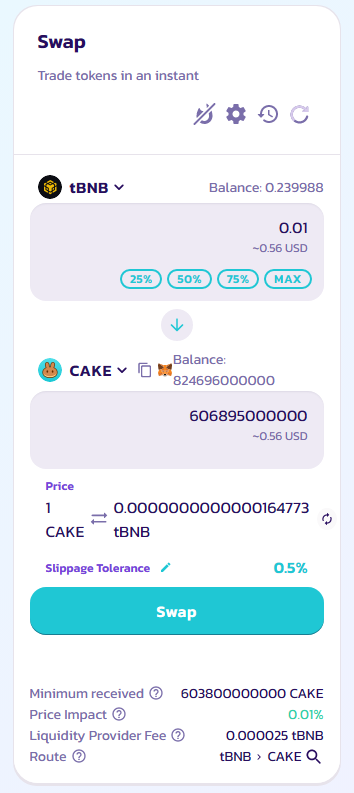make a swap using pancake smart router in solidity contract
overview
In this article i gonna show you how to make a swap using pancakeswap smart router in solidity contract.Here wo go. In this example i swap BUSD token to CAKE.Here is the address of each token:
- BUSD : https://testnet.bscscan.com/address/0x78867BbEeF44f2326bF8DDd1941a4439382EF2A7
- CAKE : https://testnet.bscscan.com/address/0xfa60d973f7642b748046464e165a65b7323b0dee
Click the link you’ll find them in bscscan testnet. If you don’t hold those tokens, nerver mind claim some from bsc faucet by clicking faucet website.
soldity
Let’s go dive into the deep.Firstly we need set a swap amount, eg:0.01 BUSD, an wed need a min out amount as well.The last parameter is path which means the path of swap tokens.When we swap busd to cake we can find a pool consist of busd and cake。So the path is simple.For some other tokens maybe the path is a litte bit longer.We have to use two or three or more pools to get the token we want. In the pancakeswap front-end page , it returns a path before we make the swap. In the solidity code we have to do it ourself.We have to get the optimal path before we make the swap.Let’s dive into the pancakeswap smart router code.
1 | interface PancakeRouter { |
There are so many swap function we can use to help use swap tokens. In this demo we use swapExactTokensForTokens. As you see there is a function named swapExactTokensForTokensSupportingFeeOnTransferTokens. We need to know what’s the difference between this two functions.
1 | function swapExactTokensForTokensSupportingFeeOnTransferTokens( |
1 | function swapExactTokensForTokens( |
After compare the above two functions we know the difference. In the swapExactTokensForTokens function the exact transfer amount is set by PancakeLibrary getAmountsOut. And in this article we use swapExactTokensForTokensSupportingFeeOnTransferTokens.
Here is the entire code from github gist : code
deploy our code
Deploy code:
1 | const hre = require("hardhat"); |
1 | npx hardhat run script/scriptName.js --network YOUR_NETWORK_NAME. |
test swap
1 | const hre = require("hardhat"); |

